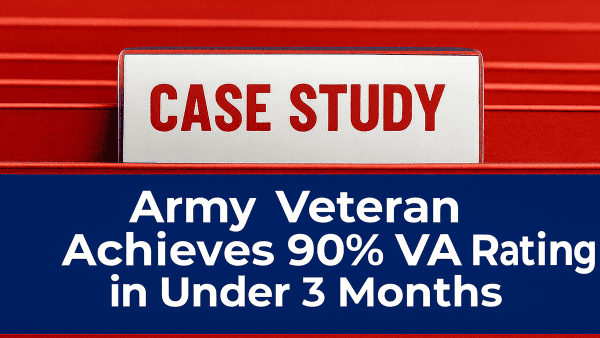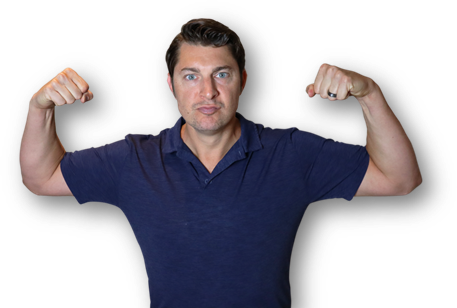Looking for Expert-Level VA Claim Answers?📱Call Us Now! 737-295-2226
Getting a schizoaffective disorder VA rating can feel complex, but it’s absolutely possible to prove service connection with the right medical evidence.
Schizoaffective disorder is a mental health condition that causes symptoms of both schizophrenia and bipolar or major depressive disorders. If you can service connect this condition, either as a direct or secondary condition, you may be able to increase your VA rating and monthly disability compensation.
Read on for more information about the VA disability ratings for schizoaffective disorder.
Summary of Key Points
- Schizoaffective disorder is a mental health condition that can be VA-rated from 0% to 100% depending on the severity of symptoms and their impact on occupational and social functioning.
- To receive disability compensation from the VA, you must prove that your schizoaffective disorder symptoms are connected to your military service.
- Even without a documented schizoaffective episode in service, service connection may be granted if medical evidence links in-service symptoms or behavioral changes to the current diagnosis.
Table of Contents
What is Schizoaffective Disorder?
To understand schizoaffective disorder, it’s first helpful to understand schizophrenia, which is a term familiar to most people. The Diagnostic and Statistical Manual of Mental Disorders (5th edition) indicates the following five symptoms of schizophrenia:
- Delusions
- Hallucinations
- Disorganized speech
- Disorganized behavior or social withdrawal
- Negative symptoms (reduction in normal thoughts, behaviors, and feelings)
Schizoaffective disorder is a mental health condition that combines schizophrenic symptoms with a mood disorder. It presents in two ways, according to the Mayo Clinic:
- Bipolar type: Symptoms of schizophrenia, plus periods of mania/hypomania and depression.
- Depressive type: Symptoms of schizophrenia, plus periods of major depression.
Related: What is the Bipolar Disorder VA Rating?
Schizoaffective Disorder VA Ratings
A schizoaffective disorder VA rating (Diagnostic Code 9211) ranges from 0% to 100%, based on the severity of symptoms and the resulting level of occupational and social impairment.
Schizoaffective Disorder VA Rating Table
| VA Rating Criteria Description | VA Rating |
| Total occupational and social impairment, due to such symptoms as: gross impairment in thought processes or communication; persistent delusions or hallucinations; grossly inappropriate behavior; persistent danger of hurting self or others; intermittent inability to perform activities of daily living (including maintenance of minimal personal hygiene); disorientation to time or place; memory loss for names of close relatives, own occupation, or own name. | 100% |
| Occupational and social impairment, with deficiencies in most areas, such as work, school, family relations, judgment, thinking, or mood, due to such symptoms as: suicidal ideation; obsessional rituals which interfere with routine activities; speech intermittently illogical, obscure, or irrelevant; near-continuous panic or depression affecting the ability to function independently, appropriately and effectively; impaired impulse control (such as unprovoked irritability with periods of violence); spatial disorientation; neglect of personal appearance and hygiene; difficulty in adapting to stressful circumstances (including work or a worklike setting); inability to establish and maintain effective relationships. | 70% |
| Occupational and social impairment with reduced reliability and productivity due to such symptoms as: flattened affect; circumstantial, circumlocutory, or stereotyped speech; panic attacks more than once a week; difficulty in understanding complex commands; impairment of short- and long-term memory (e.g., retention of only highly learned material, forgetting to complete tasks); impaired judgment; impaired abstract thinking; disturbances of motivation and mood; difficulty in establishing and maintaining effective work and social relationships. | 50% |
| Occupational and social impairment with occasional decrease in work efficiency and intermittent periods of inability to perform occupational tasks (although generally functioning satisfactorily, with routine behavior, self-care, and conversation normal), due to such symptoms as: depressed mood, anxiety, suspiciousness, panic attacks (weekly or less often), chronic sleep impairment, mild memory loss (such as forgetting names, directions, recent events). | 30% |
| Occupational and social impairment due to mild or transient symptoms which decrease work efficiency and ability to perform occupational tasks only during periods of significant stress, or symptoms controlled by continuous medication. | 10% |
| A mental condition has been formally diagnosed, but symptoms are not severe enough either to interfere with occupational and social functioning or to require continuous medication. | 0% |
Proving Service Connection
To receive a schizoaffective disorder VA rating, you must prove service connection. Even if you didn’t experience a full schizoaffective episode during service, you could still establish a link to in-service symptoms or behavioral changes, such as isolation, mood changes, anxiety, or reduced personal hygiene, that a medical professional can relate to your current diagnosis.
Proving direct service connection requires meeting all three criteria commonly referred to as the Caluza Triangle:
- A current medical diagnosis of schizoaffective disorder,
- Evidence of an in-service event, injury, disease, or aggravation, and
- A medical nexus (the link between the condition and your service) via competent medical evidence
Schizoaffective disorder could also be claimed as a secondary connection if it’s related to an already service-connected condition, such as PTSD or TBI. Proper medical evidence is required to show the link between the service-connected condition and schizoaffective disorder.
Relevant Medical Evidence to Support Your Claim
You must show that your schizoaffective disorder is connected to your military service. Providing the VA with relevant medical evidence can help strengthen your VA disability claim. This can include:
- A current schizoaffective disorder diagnosis performed by a licensed mental health professional.
- Relevant medical records, including your schizoaffective disorder diagnoses, any treatment received, and medical record documentation that links your condition to your military service and shows that your condition started during or shortly after your military service.
- Personal statements from friends, colleagues, or family members that describe your symptoms and their relationship to your military service.
- Documented incidents of thinking and behavior that align with the symptoms of schizoaffective disorder.
Note: If you haven’t yet been diagnosed with schizoaffective disorder, it may take time for mental health providers to identify your condition; this is because schizoaffective disorder presents symptoms of both schizophrenia and bipolar disorder and is diagnosed by ruling out other possible conditions using a series of various tests and exams.
How to File a VA Claim
As soon as you receive your schizoaffective disorder diagnosis, medical records, and other documentation, you can begin the process of filing your VA disability claim. Items that strengthen your claim include:
- Relevant service records
- Quality medical evidence (e.g., a medical diagnosis, psychological testing results, a credible nexus letter)
You can file your claim online, through mail or fax, or in person at your local VA center. If filing through mail, fax, or in person, you’ll need to download and complete the VA Form 21-526EZ.
Related: How to File a VA Claim Online
Schizoaffective Disorder and Other Mental Health Conditions
Many mental health conditions have comorbidities, or additional mental health conditions presenting simultaneously.
Schizoaffective disorder can be difficult to diagnose because it shares symptoms with both schizophrenia and bipolar disorder. Comorbidities include:
- Anxiety disorders
- Posttraumatic stress disorder (PTSD)
- Attention-deficit hyperactivity disorder (ADHD)
- Substance use disorders / Dual Diagnosis
The VA evaluates each service-connected mental health condition individually but avoids assigning separate ratings for the same symptoms. If you have schizoaffective disorder and anxiety disorder, you may receive separate ratings only if the symptoms are distinct and do not overlap.
For example, if you receive a 50% schizoaffective disorder VA rating and a 30% rating for anxiety that involves distinct symptoms, your combined rating would be calculated according to VA rules for combining disabilities.
Learn more about VA mental health ratings, such as mental health conditions that qualify for VA ratings, here.
TDIU for Schizoaffective Disorder
If you are unable to secure or follow substantially gainful employment due to schizoaffective disorder or other mental health conditions but don’t rate at 100% VA disability, it’s still possible to receive full compensation from the VA.
Total disability based on individual employment, or TDUI, pays at the same rate as 100% VA disability rating, if you meet the following criteria:
- A single service-connected disability rated at least 60% (or higher) OR
- A combined rating of 70% (or higher) with at least one service-connected disability rated at 40% or higher.
Conclusion
Schizoaffective disorder is a mental health condition that can impact your ability to function in everyday life. However, with a proper diagnosis and connection to military service, you could be eligible for VA disability compensation and benefits.
While schizoaffective episodes may not have occurred during your service, you could still service connect the condition through early warning signs. If you’re unable to work due to schizoaffective disorder, you could still get compensated at 100% disability through the total disability based on individual unemployability (TDIU).
Want Expert-Level Support for Your VA Disability Claim? WE GOT YOUR SIX!

- VA Claims Insider is the #1 most trusted name in VA disability claims.
- Work directly with a VA claims coach who can educate you through the claims process.
- 25,000+ disabled veterans have served in our membership programs since 2016.
- 30% average rating increase for veterans who complete our #1-rated Elite program.
- 4.7/5.0 average rating out of 5,500+ total reviews; over 4,500 5-star reviews.
FAQs | Frequently Asked Questions
Is schizoaffective disorder a VA disability?
Yes, a schizoaffective disorder VA rating (Diagnostic Code 9211) ranges from 0% to 100%, depending on the severity of symptoms and their impact on occupational and social functioning. Service connection is determined by a current medical diagnosis of schizoaffective disorder; evidence of an in-service event, injury, disease, or aggravation; and a nexus (the link between the condition and your service) via competent medical evidence.
Can schizoaffective disorder be considered service-connected?
Yes, schizoaffective disorder can be service-connected if you can show that your military service caused your condition.
Can I join the military with schizoaffective disorder?
No, a current diagnosis or history of schizoaffective disorder is considered a “disqualifying condition” for military service. As of July 2025, waivers for psychotic disorders are no longer accepted.
What is the schizoaffective disorder VA rating?
A schizoaffective disorder VA rating (Diagnostic Code 9211) ranges from 0% to 100%, based on the severity of symptoms and the resulting level of occupational and social impairment.
What is the average VA disability rating for a mental health condition?
The average VA rating for all mental health conditions is 70%. Symptoms must be severe enough to significantly impair normal, everyday, independent functioning and activity.
About the Author

Katie McCarthy
Katie McCarthy is a writer and editor with experience in daily news and digital and print magazine publishing. She honed her editorial (and firearms) skills at Guns & Ammo before helping launch Black Rifle Coffee Company’s Coffee or Die Magazine as the managing editor. She holds degrees in English (BA) and public administration (MPA). Katie is a military spouse and word nerd who enjoys reading, hiking, camping, gardening, and spending time with her family.



